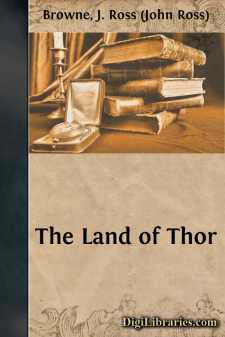Categories
- Antiques & Collectibles 13
- Architecture 36
- Art 48
- Bibles 22
- Biography & Autobiography 813
- Body, Mind & Spirit 142
- Business & Economics 28
- Children's Books 16
- Children's Fiction 13
- Computers 4
- Cooking 94
- Crafts & Hobbies 4
- Drama 346
- Education 46
- Family & Relationships 57
- Fiction 11829
- Games 19
- Gardening 17
- Health & Fitness 34
- History 1377
- House & Home 1
- Humor 147
- Juvenile Fiction 1873
- Juvenile Nonfiction 202
- Language Arts & Disciplines 88
- Law 16
- Literary Collections 686
- Literary Criticism 179
- Mathematics 13
- Medical 41
- Music 40
- Nature 179
- Non-Classifiable 1768
- Performing Arts 7
- Periodicals 1453
- Philosophy 64
- Photography 2
- Poetry 896
- Political Science 203
- Psychology 42
- Reference 154
- Religion 513
- Science 126
- Self-Help 84
- Social Science 81
- Sports & Recreation 34
- Study Aids 3
- Technology & Engineering 59
- Transportation 23
- Travel 463
- True Crime 29
The Land of Thor
Description:
Excerpt
CHAPTER I.
IMPRESSIONS OF ST. PETERSBURG.
I landed at St. Petersburg with a knapsack on my back and a hundred dollars in my pocket. An extensive tour along the borders of the Arctic Circle was before me, and it was necessary I should husband my resources.
In my search for a cheap German gasthaus I walked nearly all over the city. My impressions were probably tinctured by the circumstances of my position, but it seemed to me I had never seen so strange a place.
LABORERS AND SHIPWRIGHTS.
RUSSIAN AND FINN.
The best streets of St. Petersburg resemble on an inferior scale the best parts of Paris, Berlin, and Vienna. Nothing in the architecture conveys any idea of national taste except the glittering cupolas of the churches, the showy colors of the houses, and the vast extent and ornamentation of the palaces. The general aspect of the city is that of immense level space. Built upon islands, cut up into various sections by the branches of the Neva, intersected by canals, destitute of eminent points of observation, the whole city has a scattered and incongruous effect—an incomprehensible remoteness about it, as if one might continually wander about without finding the centre. Some parts, of course, are better than others; some streets are indicative of wealth and luxury; but without a guide it is extremely difficult to determine whether there are not still finer buildings and quarters in the main part of the city—if you could only get at it. The eye wanders continually in search of heights and prominent objects. Even the Winter Palace, the Admiralty, and the Izaak Church lose much of their grandeur in the surrounding deserts of space from the absence of contrast with familiar and tangible objects. It is only by a careful examination in detail that one can become fully sensible of their extraordinary magnificence. Vast streets of almost interminable length, lined by insignificant two-story houses with green roofs and yellow walls; vast open squares or ploschads; palaces, public buildings, and churches, dwindled down to mere toy-work in the deserts of space intervening; countless throngs of citizens and carriages scarcely bigger than ants to the eye; broad sheets of water, dotted with steamers, brigs, barks, wood-barges and row-boats, still infinitesimal in the distance; long rows of trees, forming a foliage to some of the principal promenades, with glimpses of gardens and shrubbery at remote intervals; canals and dismal green swamps—not all at one sweep of the eye, but visible from time to time in the course of an afternoon’s ramble, are the most prominent characteristics of this wonderful city. A vague sense of loneliness impresses the traveler from a distant land—as if in his pilgrimage through foreign climes he had at length wandered into the midst of a strange and peculiar civilization—a boundless desert of wild-looking streets, a waste of colossal palaces, of gilded churches and glistening waters, all perpetually dwindling away before him in the infinity of space. He sees a people strange and unfamiliar in costume and expression; fierce, stern-looking officers, rigid in features, closely shaved, and dressed in glittering uniforms; grave, long-bearded priests, with square-topped black turbans, their flowing black drapery trailing in the dust; pale women richly and elegantly dressed, gliding unattended through mazes of the crowd; rough, half-savage serfs, in dirty pink shirts, loose trowsers, and big boots, bowing down before the shrines on the bridges and public places; the drosky drivers, with their long beards, small bell-shaped hats, long blue coats and fire-bucket boots, lying half asleep upon their rusty little vehicles awaiting a customer, or dashing away at a headlong pace over the rough cobble-paved streets, and so on of every class and kind....


